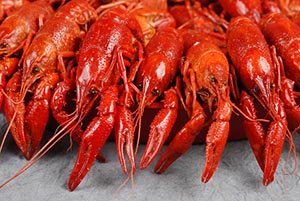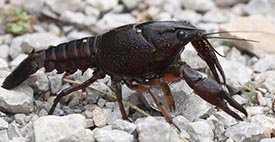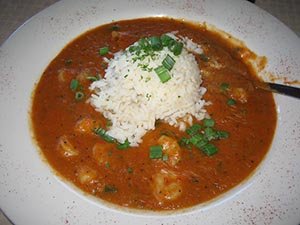Crawfish Nutrition facts
Crawfish is a small, freshwater crustacean related to shrimps, lobsters, and crabs. Worldwide, crawfish include more than 600 species. Some species are identified by the coloring of their claws (white-clawed crayfish, red-clawed crayfish).
Scientific name: Cambarus sp. They are also known by names as crayfish, crawdads and mudbugs.
 |
| Boiled crayfish. Photo by Paula Ouder, courtesy Louisiana Sea Grant College Program |
Edible crawfish chiefly comprises three families:
Cambaridae: Red swamp crawfish (Procambarus clarkia) and white river crawfish (P. zonangulus),
Astacidae: Giant Tasmanian crayfish (A. gouldi),
Parastacidae.
All species of crayfish found in the eastern United States belong to Cambaridae, the largest family of crayfish.
Description:
 |
| Crayfish. Photo credit: Andy Reago. |
Crawfish has similar external features as lobsters but in a smaller version. This crustacean, like all arthropods, is a decapod (one pair of claws and four pairs of legs) and has an encasing exoskeleton made out of the structural polysaccharide "chitin." Claws function as tools for defense, food gathering, and burrowing. Their four pairs of walking legs assist them in rapid movement across the bottom substrates of their aquatic habitats.
Crayfishes vary dramatically in size, color, and general appearance, usually measuring 2-6 inches (6-14 cm) in length. Its white meat tinged with pink is lean, delicate, and more or less compact, depending on the species.
Life cycle:
Crawfish are well adapted to the cyclical low-water dry conditions and high-water flood conditions common to their natural habitats. The female lays eggs in its second year of life to raise many juveniles in the burrow. Their lifespan is about 2-3 years; however, giant Tasmanian crayfish (A. gouldi) can live for many decades.
Habitat:
live in a wide variety of habitats, including lakes, ponds, rivers, streams, springs, and swamps. They spend most of their time in burrows to escape from predators, to spawn, and during adverse conditions such as drought.
Crayfish are night hunters and consume both plant and animal materials such as aquatic plants, mollusks, insect larvae, mature insects, tadpoles, amphibian eggs, and small fish.
Health Benefits of Crawfish
Crawfish, being a crustacean, is a low-calorie, low-fat, white meat seafood. 100g of its tail meat holds just 77 calories and 0.95g of fats.
Their lean white tail meat is a good source of protein. Their lean meat composes 15.97 g/100g (27% of RDI) of protein, being complete in all essential amino acids in healthy proportions.
Research studies suggest that eating seafood can decrease the risk of heart attack, stroke, obesity, and hypertension. Seafood is low in saturated fat and higher in “heart healthful” polyunsaturated fat, including omega-3 fatty acids.
American Heart Association recommends consumption of seafood, including crustaceans, to fulfill requirements of essential fatty acids, protein, minerals, and fat-soluble vitamins.
Unlike oily fish like salmon, crawfish is a minor source of vitamin-A and long chain omega-3 fatty acids (PUFA).
It composes just 57 IU/100g of vitamin A and a total- 0.152g of omega-3 fatty acids. Vitamin A and omega-3 are essential for healthy mucosa and skin.
Living in freshwaters, crayfish essentially prey on small insects and zooplankton which are the finest sources of B-complex vitamins. Crawfish meat is a good source of folates, niacin, vitamin B6, thiamin, and riboflavin.
Invertebrates, like crawfish, are at the bottom of the food chain and concentrate very small amounts of heavy metals like mercury. The Food and Drug Administration (FDA) recommends that pregnant women eat at least 8 ounces and up to 12 ounces (340 grams) of a variety of seafood lower in methyl-mercury a week.
Crayfish are a very rich source of minerals including iron (10.5% RDI), selenium, iodine, calcium, zinc, potassium, phosphorus (36.5% RDI), and magnesium.
| Principle | Nutrient Value | Percent of RDA |
|---|---|---|
| Energy | 77 Kcal | 4% |
| Carbohydrates | 0 g | 0% |
| Protein | 15.97 g | 28.5% |
| Total Fat | 0.95 g | 5% |
| Cholesterol | 0 mg | 0% |
| Dietary Fiber | 0 g | 0% |
| Vitamins | ||
| Folates | 37 μg | 9% |
| Niacin | 2.208 mg | 14% |
| Pyridoxine | 0.108 mg | 8% |
| Riboflavin | 0.032 mg | 2.5% |
| Thiamin | 0.070 mg | 6% |
| Vitamin-A | 53 IU | 2% |
| Vitamin-C | 1.2 mg | 2% |
| Vitamin-D | 0 IU | 0% |
| Vitamin-E | 2.85 mg | 19% | Electrolytes |
| Sodium | 58 mg | 4% |
| Potassium | 302 mg | 6.4% |
| Minerals | ||
| Calcium | 27 mg | 2.7% |
| Iron | 0.84 mg | 10.5% |
| Magnesium | 27 mg | 7% |
| Phosphorus | 256 mg | 36.5% |
| Zinc | 1.30 mg | 12% |
| Omega-3 fatty acids (PUFA) | ||
| EPA (20:5 n-3) | 0.104 g | -- |
| DPA (22:5 n-3) | 0.010 g | -- |
| DHA (22:6 n-3) | 0.038 g | -- |
Buying
Crayfish sold live or cooked, frozen or canned. You can buy live crayfish from nearby seafood markets for freshness in the recipes. Several stores sell boiled, frozen, and ready-to-eat crawfish in vacuum packs. Buy from authentic sellers with a pleasant smell, firm shell, and claws intact.
Storing
Crawfish can live 2-3 days away from their natural habitat if placed in a saltwater fish tank. After buying, avoid keeping them at room temperature. Cook immediately, or cover with a damp cloth and place in the fridge, briefly. Boiled crawdads are stored in the fridge for 1-2 days.
For prolonged storage (1 month); boil and remove meat from the shell, then place in containers in the freezer, covered in brine, and close with a lid.
Preparation
Crayfish is prepared in the same way as lobster, crab, and shrimp, which it can replace in most dishes. Only the tail of the crayfish is eaten, while its crushed shell can flavor fish stock, bisque, or butter.
To cut crayfish into two, position the tip of a knife in the center of the head and pierce down to the board. Turn it around and beginning at the head end, spit the crayfish in half, lengthwise. Remove the intestine at the time of cooking. Pull gently on the small fin underneath the tail and the intestine should come out; if not, remove making a lengthwise slice with the point of a knife.
For tastier crawfish, before boiling, block the holes in the shell with fresh crustless bread, preferably pressed between fingers. Crawfish can be boiled, steamed, grilled, or poached in fish stock.
Once cooked, crayfish turn into maroon, irrespective of its original color.
Here are some serving ideas:
 |
| crawfish etouffee. Photo credit: Luis Tamayo. |
Crawfish is cooked as a bisque, gratin, soufflé or mousse as well as used in salads or gratineed with other kinds of seafood.
Crawfish and corn chowder is a relishing appetizer.
Crawfish is named as the official state crustacean of Louisiana. Many Creole and Cajun-style restaurants serve dishes like crawfish étouffée with rice.
Crawfish boil is a mouth-watering recipe in Louisiana, crawfish boiled in large pot with vegetables like potatoes, onions, corn, bell pepper, celery, and garlic and serve hot.
The shell can be used to make fish stock and to flavor bisques, stews, and sauces.
Prepare French-style crawfish gratin and serve Japanese-style chilled miso soup with crayfish, cucumber and sesame.
Safety profile
Allergy to crustaceans may appear in 1% of the population and is more common in teenage and adult life than very early childhood.
Many allergic reactions to seafood are mild and cause hives (urticaria), tingling of the throat and mouth, swelling (angioedema), and/or gut reactions (vomiting, diarrhea). (Medical disclaimer).
Also read ≻≻-
≻≻- Mercury in Fish: Health Benefits, Risks, and Safe Choices
≻≻-Shrimp nutrition facts and health advantages.
≻≻-Lobster nutrition facts and health benefits.
≻≻-Trout nutrition facts and health benefits.
≻≻-Anchovies nutrition facts and health benefits.
≻≻-Back to Seafood from Crawfish nutrition facts and health benefits.
Further reading (Links opens in new window):
Omega-3 Fatty Acids: An Essential Contribution.